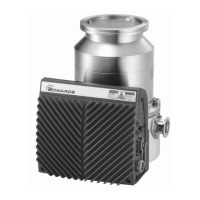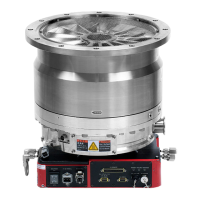STP-301/451 Series Instruction Manual
7-7
Operation
7.6 Remote Operation (CON4: Optional Accessory)
(Read through Section 8.3, "CON4 connector" befor use.)
The CON4 connector (special accessory) is available in the STP-301/451 series in order to
maintain compatibility with the remote specification of the previous model of the
STP-200/300/400 series.
This connector can maintain compatibility with the remote I/O signal of the STP-200/300/400
series.
When using the CON4 connector, follow the procedure below:
1) Switch "ON" the No.4 switch of the DSW-B on the top panel.
(Refer to Figure 6.3, "STP Control Unit Top Panel" for the position of "DSW-B".) In this
case, remote input from I/O TB2 terminal is invalid.
2) Slide the "MANUAL/REMOTE" changeover switch on the STP control unit front panel to
"ON". The "REMOTE" lamp illuminates.
7.6.1 Powering ON
1) Switch "ON" the breaker on the STP control unit rear panel.
(To prevent incorrect operation, a metal fitting is attached to the breaker. Loosen the
screw, lift the metal fitting, then secure it.)
The magnetic bearing functions and the rotor levitates (POWER ON state).
The "POWER" lamp illuminates.
2) The STP control unit executes the self test. If no error is found, the LCD displays
"LEVITATION".
7.6.2 Starting/Stopping the STP Pump
Table 7.3 Starting/Stopping the STP Pump during Remote Operation (CON4)
Starting the Pump Stopping the Pump
Input 24 V DC between (3)‐(15) (pin for start
signal) for 0.3 seconds or more.
Connect the (+) side to (3), and the (-) side to (15).
However, when inputting the signal
simultaneously with switching "ON" the breaker on
the rear panel, continue to short the circuit for 5
seconds or more.
Input 24 V DC between (4)‐(16) (pin for
stop signal) for 0.3 seconds or more.
Connect the (+) side to (4), and the (-)
side to (16).
This STOP signal has priority over he
START signal.
◇ The STP pump can be started by remote operation with any message displayed on
the LCD.
◇ Although the STP pump sounds for several seconds while it is accelerating, this is
not an indication of abnormality.

